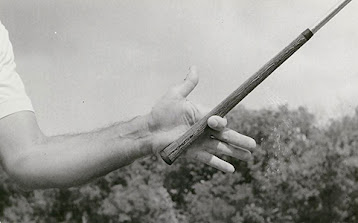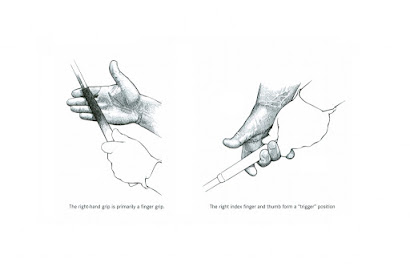Spend any time at all searching the Internet about the vagaries of the golf swing and you're likely to run into forum discussions about The Golfing Machine, a complex book of golf theory by Homer Kelley. TGM has gained somewhat of a cult status among golfers--professionals and amateurs alike. Great teaching pros have taken some of its teachings and "dumbed them down" for the rest of us.
Part of what makes TGM complex is a description of the physics involved in a golf swing. But here's something that you may find useful that isn't too hard to understand. TGM talks about Power Accumulators and there are four of them. PA#1 is the bending and straightening of the right arm. PA#2 is the cocking and uncocking of the left wrist. PA#3 is the rolling of the left forearm (Hogan called this supination). And finally (the one that really increased my power and consistency and made PA#3 release easier), PA#4--the angle between upper left arm and shoulder line that's strongly associated with the pressure felt between the upper left arm against the left pectoral muscle that begins in the backswing, increases during the downswing, and releases when the upper left arm is finally launched off of the chest, which also releases the angle of PA#4.
Release the Power Accumulators in the correct sequence and degree and you can deliver a nice, powerful, repeatable shot with good direction control. You probably already use some of them to one extent or another.
One that took me a while to understand was PA#4. Some golf instructors try teach this by telling you to "stay connected," and they recommend various drills that try to instill this feeling, such as hitting with a towel, head cover, or even a bit of one's shirt held under the left arm pit. I personally don't find those drills helpful, because I don't think they convey the transfer of energy (increasing pressure) that needs to occur between that left pectoral muscle and the left arm during the downsing. The golf swing is powered from the feet, into the legs, up through the rotating torso, out to the arms, and finally through the club and into the ball.
What's helpful to me (for PA#4) is to feel that my upper left arm pulls across my chest on the backswing, creating a pressure point (this pressure point is called Pressure Point #4 or PP#4 in TGM). That pressure between the upper left arm and chest should increase on the downswing, because the turning of the chest and shoulders (due to the pivot action of the upper body) is pulling the arm tight against the chest initially (and the arm pulls the club as a result), because the club and arm are lagging. This happens while the arms are dropping. This means that the correct sequence of motion in the kinetic chain is: left hip turns and eventually pulls the left shoulder which increases pressure in the upper left arm against the chest which helps pull the club into the ball.
It's important to note that the hips should still start the downswing and the arms must still drop while the back is turned; it's easy to focus too much on that chest-arm pressure point and then spin out with the shoulders--a sort of diving motion that will cause an outside-in swing path. This will cause fades, slices, and pulls, because the path will be across the ball. The hips must rotate first and create separation between the shoulders (keeping the back to the target initially). Then when the shoulders finally rotate, in-turn, the pressure can build in PA#4 and really power the left arm through the shot.
And keeping the head back behind the ball is important to keep the proper spine angle through impact (secondary axis tilt) to avoid spinning out and diving forward with the shoulders; the right shoulder should move down-plane towards the ball, not over-plane. It might be helpful, therefore, to think of the left chest muscle rotating forward and upward as it launches the arm. For most this won't be a problem, but it's something of which to be aware. If shots suddenly start slicing or pulling, make sure that the legs start the motion first.
Now, about PA#3. I've posted before about the flat left wrist and how to maintain that while supinating the left forearm, such that the wrists DO NOT flip at impact. And I've also posted about complete extension--having both arms extended immediately after impact. Properly using PA#4 allowed me to figure out the correct release of PA#3. Keeping the grip relaxed allows the left arm to NATURALLY supinate ever so slightly to the left when the left arm is propelled off of the chest (release of PA#4); this is why so many teachers have said that "rolling the forearms" is NOT a consciously controlled action. It also makes sense on why gripping tighter can slow PA#3 and aid in fading the ball, while relaxing the grip can facilitate drawing the ball.
Finally, an explosive, dynamic motion helps to maintain the lag when striving to use PA#4 and PP#4 to drive the swing. Swing faster! Some instructors say don't swing hard (with tension) but swing fast, while some use "hard" and "fast" interchangeably. You want to release PA#4 by having the left arm EXPLODE and SNAP off the chest dynamically. Everything can stay loose while this happens, regardless of whether you believe this means swinging "faster" or "harder." Swinging faster (releasing PA#4 quickly through the ball) creates more lag and more distance. Period. It's entirely possible to swing faster and still feel "in control."
It's important to note that PA#4 is associated with a swinger's style--pulling the club through using the left side, as opposed to the hitter's style--pushing the club through with PA#1 and PP#3.
Power accumulator #4 is loaded when the left arm is pulled across the chest wall during the backswing. At the end of the backswing, the left arm should be lying across the upper chest wall and there should be a sense of pressure at pressure point #4 - the point where the left upper arm lies tightly against the left upper pectoral area...
During the downswing, the left arm moves away from the upper torso and power accumulator #4 is regarded as being completely released when there is an approximately 90 degree angle between the straight left arm and the upper torso between the shoulder sockets - which usually happens by impact (actually at the end of the followthrough when both arms are fully straight).
This power accumulator 'loads' when the golfer takes the club back and that angle turns into a 45 degree angle. Then it 'releases' once the angle goes back to 90 degrees. A favorite of 'swingers' who often load this power accumulator and then just pivot their body thru and hold onto the power accumulator for as long as they can. It's often known as 'throwing/blasting the left arm off the chest.'
3Jack Golf Blog: Understanding the Basics of TGM -- Part V
When the upper torso decelerates, the left arm can freewheel away from the chest wall towards impact at a faster speed because there is no impedance to the freewheeling movement of the left arm away from the chest wall. One can think of the left arm being passively catapulted away from the chest wall, and the distance between the hands and the right shoulder should progressively increase during the mid-late downswing...
Note that the lower lumbar spine has moved towards the target (as a result of the pelvic shift-rotation movement) and that he has acquired a significant amount of secondary axis tilt as a result of the hip squaring action. The secondary axis tilt allows the right shoulder to move downplane when the shoulders start to rotate perpendicularly around the rightwards tilted spine...
A swinger powers the golf swing via a pivot-driven swing action that causes the left arm to be catapulted off the chest wall towards impact. The freewheeling left arm/hand pulls the clubshaft towards impact, and this pull-action is called drag-loading. The right arm does not supply any push-power in a swinger's swing action. If a golfer wants to apply right arm push-power in a drive-loading manner, then he must learn how to become a hitter...
A golfer should never attempt to actively roll the left hand into impact via an active hand-wrist rollover action. Some golf instructors incorrectly teach a swing methodology where they recommend that a golfer actively roll the hands over through the impact zone - and this active hand roll-over action is called a hand crossover release action...
If a golfer can get the left arm to swing freely and fast towards impact in the downswing, then he will hit the ball a long way. Power accumulator #4 is called the master power accumulator, and it supplies most of the swing power in a left arm swinger's action.
I heard him say to my Dad, "The kid has a nice swing. If you don't mind me saying so let me give you one tip. "Tell your son to Swing Hard! Don't worry about direction so much now. Swing hard now and worry about direction later. It's very difficult to get clubhead speed later on once you've learned a slower swing."...The key to swinging hard is in the downswing, not the backswing! Your backswing should still be as slow as you're natural tempo allows...Swinging hard and feeling comfortable with it will take time, especially if you've been swinging easy for years.


